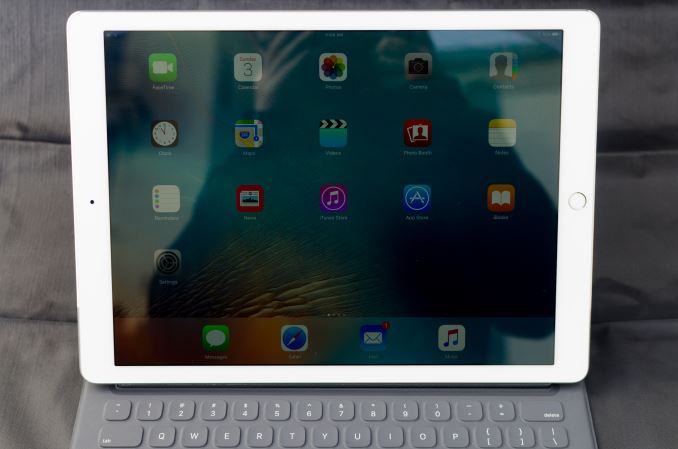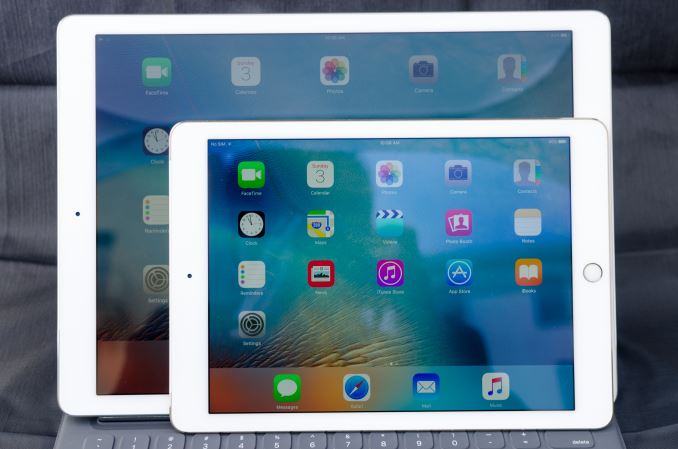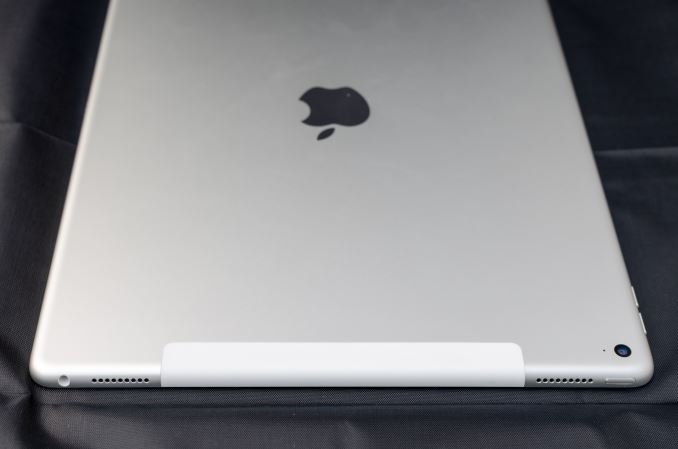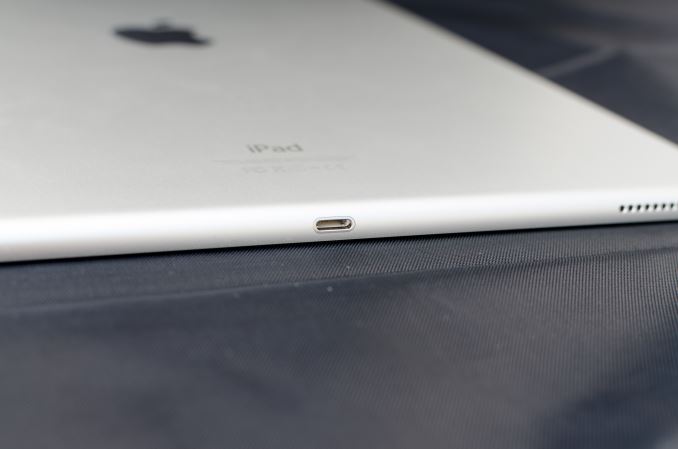The Apple iPad Pro Review
by Ryan Smith, Joshua Ho & Brandon Chester on January 22, 2016 8:10 AM EST
At this point it probably isn’t a secret that tablet sales have leveled off, and in some cases they have declined. Pretty much anywhere you care to look you’ll see evidence that the tablet market just isn’t as strong as it once was. It’s undeniable that touch-only tablets have utility, but it seems that the broader market has been rather lukewarm about tablets. I suspect at least part of the problem here is that the rise of the phablet has supplanted small tablets. Large tablets are nice to have, but almost feel like a luxury good when they’re about as portable as an ultrabook. While a compact laptop can’t easily be used while standing, or any number of other situations where a tablet is going to be better, a compact laptop can do pretty much anything a touch-only tablet can. A laptop is also going to be clearly superior for a significant number of cases, such as typing or precise pointing.
As a result, large touch-only tablets feel like they’ve been limited to home use as a computer away from the computer. Tablets are great when you’re on the couch or in bed, but once you get to this point there are some obvious questions as to whether it makes sense to drop $500+ USD on a tablet that seems to have relatively limited utility. The Surface lineup has been showing signs of growth, but in general the Surface is more of a mix between laptop and tablet rather than a tablet. I would argue that given the OS and overall design that the Surface and Surface Pro are really more laptop than tablet, even if at the hardware level the Surface Pro 4 and Surface 3 are basically tablets with kickstands and keyboard covers.
If you’re guessing that this means Apple has had some issues with growing sales of their iPad lineup, you’d be right. From my first experiences with the iPad 3, I was impressed with the improved user experience for things like web browsing and other smartphone tasks, but I never really felt like it made enough sense to get one for myself. The iPad Air 2 was once again impressive and I felt like I could recommend it to other people that wanted a tablet, but I personally struggled to come up with a reason why I would buy it.
This brings us to the iPad Pro. This is probably the first time Apple has seriously deviated from traditional iPad launches, putting together a tablet built for (limited) productivity and content creation rather than just simple content consumption, creating what's arguably the iPad answer to the Surface Pro. To accomplish this, Apple has increased the display size to something closer to that of a laptop, and we see the addition of a stylus and a keyboard cover for additional precision inputs. Of course, under the hood there have been a lot of changes as well, so the usual spec sheet can be found below to summarize those changes.
| Apple iPad Air 2 | Apple iPad Pro | |
| SoC | Apple A8X 3 x Apple Typhoon @ 1.5GHz |
Apple A9X 2 x Apple Twister @ 2.2GHz |
| GPU | PowerVR 8 Cluster Series6XT (Apple GXA6850) |
PowerVR 12 Cluster Series7XT |
| RAM | 2GB LPDDR3 | 4GB LPDDR4 |
| NAND | 16/64/128GB | 32/128GB |
| Display | 9.7" 2048x1536 IPS LCD | 12.9" 2732x2048 IPS LCD |
| Size and Mass | 240 x 169.5 x 6.1mm 437g WiFi, 444g LTE |
305.7 x 220.6 x 6.9 mm 713g WiFi, 723g LTE |
| Camera | 8MP Rear-Facing, f/2.4, 1.1 micron, 1.2MP Front-Facing, f/2.2 | |
| Battery | 27.3Wh | 38.5Wh |
| Launch OS | iOS 8 | iOS 9 |
| Cellular Connectivity | MDM9x25 Category 4 LTE + GPS/GNSS in Cellular SKU | |
| Other Connectivity | 2x2 802.11a/b/g/n/ac + BT 4.2, Apple Lightning | |
| SIM | Optional NanoSIM | |
| Price | $499/599/699 16/64/128GB | $799/949/1079 32/128GB/128GB LTE |
At a high level, the iPad Pro gains a larger display with a higher resolution, more memory, a new SoC, and a larger battery to compensate for the change in display size. In addition to these changes, the iPad Pro also brings noticeable changes to the speakers, with an increase to four speakers which allow the iPad Pro to compensate for device orientation when projecting stereo audio.
Design
The most immediate change that you can see in the iPad Pro is the sheer size. The 12.9” display of the iPad Pro basically makes it feel like you’re carrying a laptop around. I would argue that this doesn’t actually affect the portability of the iPad Pro, but this is mostly because the iPad Air 2 was something that I only carried in a backpack to begin with. People carrying their tablets in a small bag, purse, or even just in their hands will notice the difference, so the change in size might be more or less noticeable depending upon how you carry things around.
The increase in size does affect weight. After significant use, I honestly don’t think the mass is a significant issue. It does feel heavier than the iPad Air 2, but the mass distribution is such that there isn’t a ton of battery hanging out at the edges of the device where it’ll affect the moment of inertia. This does raise the question of whether Apple included enough battery for sufficient battery life, but that’s a question best left for the rest of the review.
In terms of design, the iPad Pro is rather unremarkable if you’ve ever seen an iPad Air before; it is for all intents and purposes a bigger iPad Air. On the front, the display dominates, with some bezels on the sides and top. The top has the front-facing camera, and the bottom has the home button with TouchID.
Looking at the sides of the tablet, the top edge has the power button and 3.5mm port, along with two of the four speakers. The right edge has the volume buttons, and the bottom edge has the Lightning port and the other two speakers. The left edge is mostly empty, but contains the Smart Connector for the Smart Keyboard and similar accessories.
The back of the tablet is mostly unremarkable as well. For the LTE model, an RF window is visible on the top of the device to allow LTE and other connectivity to function. For the WiFi variants, it looks like the bottom display bezel and the bottom two speakers are the RF windows, so there aren’t any visible areas that indicate where the WiFi antennas are.
Overall, the iPad Pro feels like an iPad, with nothing all that remarkable beyond its size which is carried well. I never really noticed the mass or size of the iPad Pro even if it is clearly larger and heavier than the iPad Air 2. I also didn’t notice any issues with the back cover flexing, but given enough pressure on the back cover pretty much any device this large will see some screen distortion or bending. The iPad Pro does technically regress in thickness compared to the iPad Air 2, but I never noticed the difference in practice, especially when the larger display is really what matters more.
















408 Comments
View All Comments
akdj - Tuesday, January 26, 2016 - link
I'd bet Apple switches to OLED sooner than later but the combination of IGZO and A/R glare covering/coating/glass infused front end and iOS 9's (current beta. I'm not sure if it's life in the current version of public iOS) display 'blue point' setting helps significantly at night, while reading. You're able to turn the temp down, fairly low in temp to help your eyes in the dark with a warmer screen. I use it every night. Amazing, yet small addition to iOS that - again may go unnoticed but if you take advantage of it, your eyes will thank you!I'm actually using Pencil in right hand, left free to hold or help type -- as you can navigate, open apps, manipulate the iPad and UI with the pencil but with a LOT more precision whether using a sketch pad, editing in Pinnacle or iMovie, GarageBand, or even using playback apps like dJay, games, and writing or notating a PDF, picture or just prefer sending a hand written note, it's an exceptional piece of hardware and the App Store's selection of apps, the best in history and at the lowest cost we've enjoyed ...in history.
I'm floored by the accelerated pace of apps being updated for support of both iPP and the Apple Watch. Niche product? Sure, but as a smaller iPad owner as well I'd LOVE to see this speaker tech drizzle down the line. Speakers, SoC and the 'speed' of this guy are phenomenal and anyone that spends anytime with one and apps from Adobe, MS, Autodesk or other big software devs, you'll immediately 'see' what the authors are discussing and the enjoyment many have found in ownership.
As the workplace transitions to BYOD, Jr and HSchools transition to the same --- as well as colleges, iPads of all shapes and sizes can be seen. That said, the iPP offering of the Pencil takes this another step forward for education and medical/sciences/teaching, audio production, mobile video capture, controlling your Parrot or --- as many ignorant, haven't seen or touched it yet, folks will tell you -- 'consumption'. Media; music, videos, books and magazines --- all look, sound and are more enjoyable with the larger display, significantly upgraded speakers and improved perfomance make it the perfect iPad --- for me.
I still have my rMBP 15" at home for heavier lifting my iMacs and Mac Pro in studio but the use they get is minimal compared to just a couple years ago. For everyday everyone tasks; email, surfing, comms, Twit, FB, Instagram or fill in favorite social site here -- to wifi calling, continuity with the rest of your system through handoff, and sooooo many other little things that took me away from 20 years of PC usage seven years ago to strictly OS X and iOS - with Win 7/10 on partitions of the MP in the case software is proprietary to Windows --- an ever growing anomaly rather than the usual just a half decade ago
ALL the big software developers have switched up staff and dollars from desk and laptop to mobile development --- some, over 50%! Adobe's got a dozen companion apps as does Google (that run many times better on iOS than my Android devices!) -Autodesk and Microsoft both demonstrated their software at the iPP release and I've been using the MS suite since the day it dropped, subscribed to Adobe CC since its inception and have watched literally ...weekly updates to their companion iOS software. To the extent they've rewritten ALL of their apps for 64bit compatibility opimized to iOS and are absolutely phenomenal --- certainly not 'gimped' - bit extensions of the CC suite on your MBP, MP, iMac or iPhone!
Anyway, as you seem to get it, that it's a great tablet --- as far as nighttime reading, the latest iOS drop allows much more granular control of the screen temp than Android's standard, cinema, photo, and adaptive settings. Definitely help with reading in the dark!
J
SFoster4 - Friday, January 22, 2016 - link
I am an IBM mainframe systems programmer and have been for 38 years. I have been using PC's as well for longer than many of you have been alive. I have seen and owned lots of hardware. The hardware along with the software will always evolve. Why can't you people just enjoy the changes, I do. I bought an iPad Pro. I love it. I am typing on it right now. But I am not going to lambaste others for using different devices. If there was only one solution then the hardware/software would be boring. However that might not be a bad thing because then I would have to read all of childish rants of my d*** is bigger than your d***.blackcrayon - Saturday, January 23, 2016 - link
Thank you.Unfortunately, there doesn't seem to be any correlation between maturity and interest in tech...
klassobanieras - Friday, January 22, 2016 - link
"When discussing azimuth, we’re basically looking at the angle that the stylus makes with the plane of the display, while altitude is the angle that the stylus makes relative to the normal of the display"This could be more clearly expressed - the azimuth is the angle of the pencil *within* the display plane vs the horizontal axis, not the angle it makes with the plane itself.
Constructor - Saturday, January 23, 2016 - link
Basically the Pencil gives:• pixel-precise location (x, y)
• pretty precise pressure (from manual testing – subtle pressure variations come through very well)
• relatively crude inclination (looks like only a few increments from 0..90° in the software I've checked)
• relatively precise direction when inclined (dx, dy – when shading "sideways" it knows the orientation of the point)
SaolDan - Friday, January 22, 2016 - link
The only way i could call this thing "pro" is if it could run the software i use for work. I-lux, ETC software, crestron software, ILC software, wattstopper software, i could keep naming software. Im that years down the road some of them could be available in ios but as a lesser crappy app. My boss is an ipad freak and he wont buy ipads for the company because we cant load any of the software we need to use. The device looks nice and its huge in a good way. Sucks that it doesnt have a usb drive and file system. No this cant not replace a laptop. No it cant run real games. It all depends on what use u give it.blackcrayon - Sunday, January 24, 2016 - link
You really don't understand why they used "pro"?Look, Samsung makes a 256GB 850 PRO ssd. For my job, 256 gigs isn't nearly enough. How can it be pro? Because it has features and performance above and beyond their other models. It's just a label. It doesn't mean every profession on the planet will find it to be the perfect device. I know a lot of graphics professionals that could use an iPad Pro in their workflow where an Air wouldn't have worked very well (pencil, larger screen).
Constructor - Sunday, January 24, 2016 - link
No, the Samsung "pro" SSDs are not just a different badge. They also use different chips with a different architecture for more consistent performance and for increased reliability.With the iPad it's more similar to the MacBook Pro: Anyone can use it for anything; It's mostly similar to the smaller models. But its full-page document capability, its professional-grade Pencil and its high processor performance make it more suitable for demanding work than any other model.
MaxIT - Saturday, February 13, 2016 - link
The whole "pro" bitching is utterly ridiculous. One can use a Mac Pro for Safari and Mail while another could earn real money just using an iPad mini ... Who's the "Pro" here ?MaxIT - Saturday, February 13, 2016 - link
World doesn't end at your job...And the iPad pro DOES have a file system.